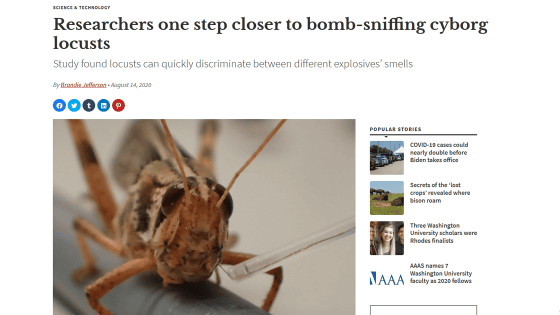Attempt to use 'cyborged grasshopper' to detect explosive odor

by
Many attempts have been made to apply the superior sense of smell of animals, including police dogs that rely on odors to look for missing people, drug detection dogs that check for drug smuggling at airports, and even sniff out land mines to help remove them. There are also mine detection dogs and mine detection mice . A study conducted by a research team at the University of Washington in the United States reportedly made progress in 'an attempt to detect the odor of explosives using the olfactory sense of cyborged grasshoppers.'
Explosive sensing with insect-based biorobots --ScienceDirect
https://www.sciencedirect.com/science/article/pii/S2590137020300169
Researchers one step closer to bomb-sniffing cyborg locusts | The Source | Washington University in St. Louis
https://source.wustl.edu/2020/08/researchers-one-step-closer-to-bomb-sniffing-cyborg-locusts/

Researchers at the University of Washington have long been trying to develop biosensors that detect the odor of explosives using a type of grasshopper called
'It was unclear if grasshoppers could be identified by smelling explosives because explosives have no ecological significance,' said Barani Raman, a professor of the research team. He points out that even if it did, it might not identify it as a meaningful signal.
Therefore, the research team experimented whether to identify the odor of explosives by exposing the grasshoppers to the odor of explosives and at the same time detecting and analyzing brain waves. In order to detect the brain waves of grasshoppers, the research team performed surgical treatment while minimizing the effect on the nerve area and other organs, and inserted wire electrodes etc. into the olfactory area of the brain and fixed it.

by
The research team consists of various explosives such as trinitrotoluene (TNT) , dinitrotoluene (DNT) , trimethylenetrinitroamine (RDX) , pentaerythritol (PETN), and ammonium nitrate , which are cyborged so that brain waves can be read. Exposed to steam. Then, it turned out that grasshoppers show different brain wave reactions to the smell of various explosives such as TNT.
Also, when using grasshoppers to detect explosives, it is necessary to identify not only 'the smell of explosives' but also 'from which direction and how strong the smell of explosives'. .. Therefore, the research team mounted the grasshopper on a moving device and moved it in a transparent box while injecting steam that smells of explosives into the box through a hole, and the brain wave of the grasshopper changes depending on the concentration of steam. I investigated whether to do it.
The equipment used in the experiment is as follows. A cyborged grasshopper is mounted on the device surrounded by a red frame, and steam is injected through a hole in the box. In this experiment, it was confirmed that the brain waves of grasshoppers changed according to the concentration of steam, and it was found that grasshoppers can distinguish the strength of odor. 'The closer you are to the coffee shop, the stronger the aroma of coffee, and the farther away you are, the weaker the aroma, which is what we have observed,' said Professor Raman. I will.

In this study, it was confirmed that the grasshopper identification accuracy was superior to that of a simple device, but it seems that few individuals were able to identify the odor of explosives with an accuracy of more than 60%. Therefore, the research team ran several randomly selected grasshoppers at the same time and tested whether the accuracy could be improved by analyzing multiple data. Then, it seems that the accuracy exceeded 80% just by using 7 grasshoppers, and it was also found that the accuracy was greatly improved by combining multiple grasshoppers.
The research team also optimized the system for detecting grasshopper brain waves based on this data. With the new system, it became possible to analyze the pattern of brain waves within just 500 milliseconds after the grasshopper smelled and identify what it smelled.
'This allows the grasshoppers with embedded electrodes to be sealed and transported to remote locations,' said Professor Raman. At first glance, attempts to use grasshoppers to detect explosives may seem strange, but Professor Raman once used canaries to detect gas and pigs to look for truffles buried in the ground. He argued that the detection of explosives by grasshoppers was a similar attempt.
Related Posts:







